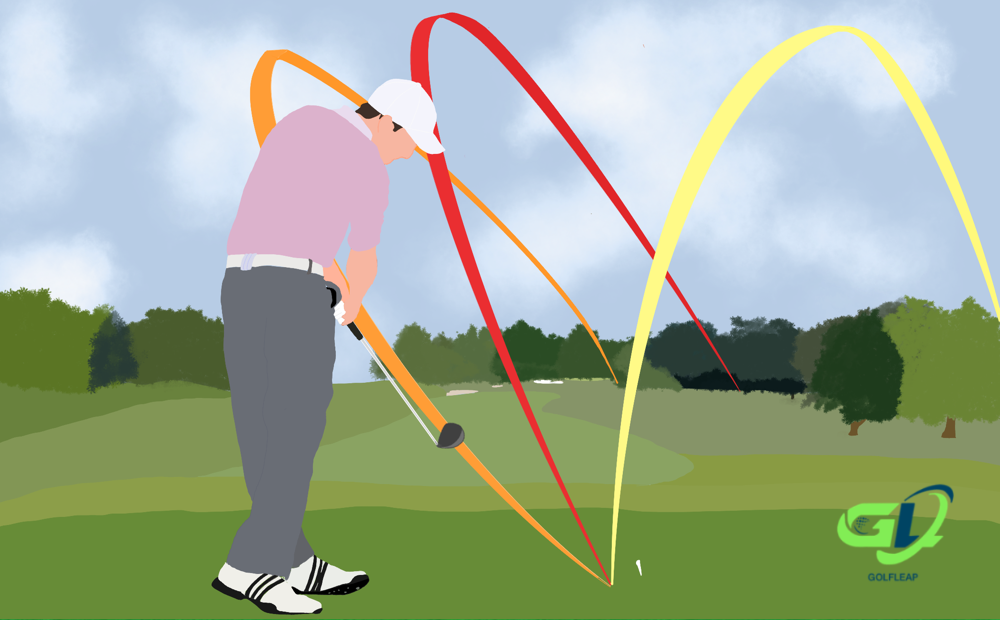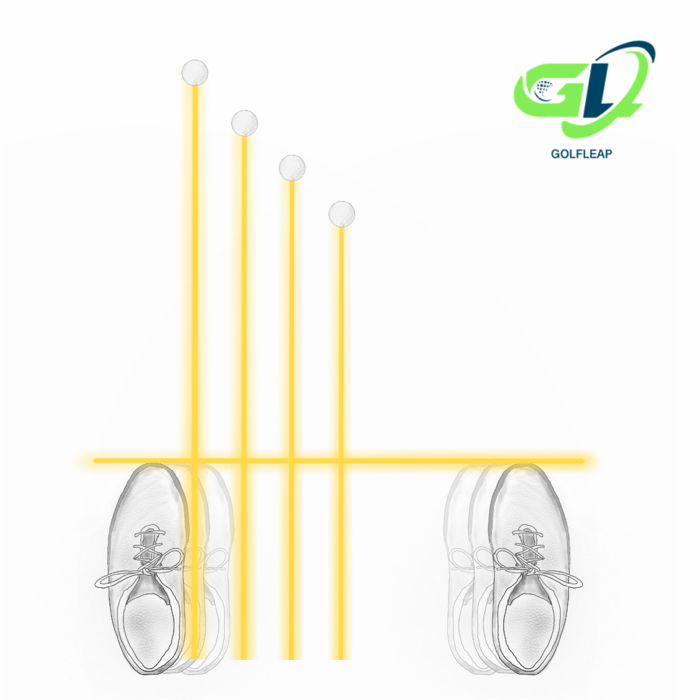
Hitting a golf slice is flat-out annoying. Sadly, it accounts for 90% of the misses for amateur golfers and is typically caused by an open club face or an out-to-in swing path, where the club head slices away from the ball from an over-the-top golf swing.
Fortunately, there are many solutions to fix a slice starting from your golf grip, your posture, all the way to the type of equipment you’re using for the job. How would I know? I was a heavy push slicer for both my driver and irons.
That’s why these 8 tips I’m about to show you were what corrected my slices and allowed me to drop from a +23 to a +10 handicap over the span of one year!
Below, I’ll cover what a golf slice is, three variants of a golf slice, how to fix them for the driver and the iron, and how to play them if necessary. After this post, you’ll find yourself hitting straighter shots and improving your handicap in the process. Let’s begin!
Quick Summary: Fix Your Golf Slice (Answer)
Fixing a golf slice starts with closing your club face on impact and not swinging out-to-in. To do this we encourage golfers to adopt a stronger grip, open their golf stance, and make sure they are using the right shafts for their golf clubs.
Table of Contents
What is a Golf Slice?
The slice is the same conceptually for a right-handed and left-handed golfer. In a nutshell, a golf slice is the excessive curve of your golf shot away from the golfer’s dominant hand. This can lead to a couple of problems that makes golf enjoyable and close to unplayable.
Why Is a Golf Slice Bad?
While hitting a slice in the practice range won’t hurt, on the golf course it will. In fact, it’s the slice that most golfers fear when hitting off the tees. Here’s why:
- Slices are hard to control: Knowing how severe your slice will pull to the right (for right handers) is extremely challenging. That’s why almost every slice you hit is going to go out of bounds. Not to mention, wind can make slices even harder to predict where your ball will land.
- Replaying the tee shot adds an extra stroke: Too many slices will ruin your golf handicap score. If you hit a slice out of bounds, that is an extra stroke penalty and it can get pretty bad if you hit two slices off the tee in a row in competitions! Pretty much that’s the end of the tournament for you.
- You lose a ton of yardage: In a bit, you’ll learn that a slice creates sides spin. That means even if you do land your ball on the green, the forward roll of the golf ball is reduced. Plus, in the air, side-spin on the ball also reduces the speed of the golf ball.
- Poses a danger to other golfers: Getting hit by a golf ball is rare, but it does happen and can be extremely dangerous. Just remember, when you do hit a slice, it is likely to fly to a different group on another hole. To reduce the odds of the ball striking someone, yell ‘FORE’ as loud as you can so others are aware of a potential incoming golf ball.
- It’s no fun: Face it, if you’re hitting slices on every hole, it’s not only crap for you but for your group too. The pace of your group slows down quite a bit and you’ll end up asking others for their precious golf balls because you ran out, which can get quite expensive overtime.
What Causes a Slice in Golf?
Typically a golf slice is caused by:
- An open club face on impact → creating a normal/ classic slice
- An out-to-in swing path → creating a push slice
- An inside-to-out swing path → creating a pull slice
With most golfers suffering from a classic and/or push slice.
That said, these three factors that create slices are often the result of a weak golf grip, the wrong golf stance, and the wrong golf equipment (we dive deeper into this later). However, it’s important to know that everyone’s slice is dependent on the swing style of the golfer!
What happens to the golf ball on a slice?
The slice creates a clockwise side spin on the golf ball for right handed golfers and an anti-clockwise side spin for left-handed golfers.
This creates something called the Magnus effect/ force on the golf, pulling the golf ball toward the direction it is spinning. The more side-spin, the worse the slice.
The 3 Types of Golf Slices
As the title mentions, there are 3 types of golf slices: the push-slice, the pull-slice, and the normal golf slice. We cover what they are and how to fix them briefly in this section, more detail on correcting your slice in detail will be covered below.
What is a Push Slice?
The push-slice is a golf slice in which the ball starts to the right of your target line and curves more towards the right (if you’re right-handed). This is usually caused by a combination of an open club face and an outside-in swing path, where you’re hitting across the golf ball from outside your swing plane.

Pull-Slice (Orange), Standard Slice (Red), Push-Slice (Yellow)
How to Fix a Push Slice?
Again, every fix to a golf shot is dependent on that golfer’s golf swing. In most cases, however, to fix a push slice, we’d position the ball slightly more in front of our golf stance, change to a stronger grip, and place our back foot one-third to half-a-foot where it would be if parallel before. This encourages a closed club face on impact while the change in stance is likely to help you rotate your body more in plane, reducing an out-to-in swing path.
A combination of all of these may be slightly overkill. You should try out different combinations to see which fits you best to correct your push slice.
Check out our guide to executing the perfect golf swing plane to fix your slice for good.
What is a Pull Slice?
The pull-slice is a golf slice that starts from the left of your target line but then slices back to the right of your target line. This is usually caused by a combination of a closed club face and an outside-in swing path.
How to Fix a Pull Slice?
Correcting a pull slice works similarly to correcting a push slice. Generally speaking, we’d still position the golf ball slightly forward of your stance, and shift back our back foot by one-third to half a foot from parallel, but we encourage a weaker grip instead.
What is a Normal/ Classic Golf Slice?
Finally, we have our normal slice, where the golf ball starts towards or slightly towards your target line but then curves right afterward. This is often caused by hitting with an open club face or making impact with the heel of the club face.
How to Fix a Classic Slice?
We cover this in detail below, but a classic slice is typically an issue with an open club face. To correct this, we encourage a stronger golf grip and placing the golf ball more forward of your stance (by roughly one golf ball). More slice tips are coming, so keep reading!
Why Am I Slicing With My Driver?
I can confidently say that 90% of you reading this are slicing with the driver. But why the driver and not the irons? Here are a couple of reasons:
- Loft: Less heavily lofted clubs generate more side-spin and less backspin, while the heavier your lofts the more natural backspin you induce on the golf ball with close to no side-spin. And remember, side-spin is what creates changes to the direction of your perfectly straight golf shots.
- Shaft Length and Shaft Flex: The driver’s shaft is the longest shaft in all your clubs, hence making the driver stupidly long at times. Though longer clubs hit farther, they’re also hard to square at impact as you’re more detached from the feel of your club face.
- You’re not familiar with swinging a driver: Swinging with the driver is very different from swinging with your irons. For all of us, we started learning golf with our irons. Jumping into the driver will therefore be much more unfamiliar to beginners. One of the biggest mistakes that create a slice with the driver is hitting too hard on the ball. Beginners always believe that there’s a need to take a rip with the driver, but remember, hitting far starts with hitting the sweet spot of the club face. Slow it down a tad bit!
Why Am I Slicing My Irons?
In some cases, you can be hitting perfect straight bombs with the driver but still be slicing your irons. You may hear that correcting the slices on your driver will also fix the slicing on your irons but that’s not always true. In fact, that’s exactly what happened to me!
What helped me was understanding and practicing the 8-slice tips I’m about to show you below. The catch is, I use a different combination of these slice corrections for the driver and for my irons. Remember when I told you that the golf swing is different for your driver and for your irons?
9 Tips For Fixing Your Golf Slice
There are a few main factors that contribute to the golf slice. Let’s take them on one-by-one and learn how each of them may affect your golf swing.
Tip#1: Switching to a Stronger Grip
The grip is the first thing any golfer should be concerned about when it comes to fixing a golf slice.
Most slicers have a hard time squaring their club face because their grip is too neutral. These golfers should consider switching to a stronger grip which allows the club face to close/ square itself at impact. To change to a strong grip simply:
- Set up your club flush to the ground, where the bottom edge of the golf club is parallel and resting with the ground.
- Rotate the club head roughly 45 degrees counterclockwise.
- Without adjusting for the rotated club head, grip your golf grip how you normally would if the club head was in its neutral position.
- Finally, rotate club head clockwise, back to its neutral position.
A stronger golf grip may feel very awkward at first, but you’ll get used to it overtime.
Tip# 2: Perfect Grip Pressure For the Golf Slice
For grip pressure, you never want to grip the club at 100%. Too much pressure on your grip leads to tension in your upper body and a higher chance that you’ll swing over the top of your golf ball.
A good feel for the right amount of grip pressure is with a wet towel. Twist the towel just to the point when the water is about to drip, that’s the pressure you want on your grip.
Tip# 3: Checking Your Posture and Stance
If you’re stance and posture are parallel to your golf ball but you’re still slicing the ball, try flaring out your lead foot (the left foot pointing slightly more, but less than 45 degrees, towards the target) or offsetting your back foot by shifting it backward by roughly one-inch from the tips of your lead foot.
Doing either ‘frees up’ your hips, allowing them to rotate more during your golf swing, potentially fixing an outside-in swing which is often caused by a lack of hip movement.
Tip# 4: Fix your slice swing path + Head Behind the Ball
Another thing to check for when fixing your golf slice is your head positioning.
Many golfers have a bad tendency of turning their face towards the target during setup in hopes to keep the golf ball from slicing. However, this position inhibits a proper shoulder turn and sets you up for an even more outside-in swing path.
To have your head positioning benefit your swing, you must keep it behind the golf ball throughout your entire golf swing. To do this, set up with a slight tilt with your upper body away from your target and stop when your left ear is aligned with the back of the golf ball at the address. Maintain
Tip# 5: Don’t Rush Your Downswing and Use Your Hips
Rushing your golf swing does not generate more speed but will ruin your tempo while creating an even worse slice. Most amateurs do not swing with their hips but with their arms. This, coupled with a rushed golf swing, results in the collapse of the right shoulder and once again, an over-the-top swing path.
To have your head positioning benefit your swing, you must keep it behind the golf ball throughout your entire golf swing. To do this, you’ll need to make sure your head is positioned correctly during your setup.
Start by setting up with a slight tilt with your upper body away from your target and stop when your left ear is aligned with the back of the golf ball. Maintain this head positioning throughout your golf swing (especially during impact), except when you’ve reached your finish.
Tip# 6: Choosing the Right Shaft Flex
It’s a no-brainer that the golf club you use can be the culprit to your slices. Most amateurs start with unfitted or second-handed clubs, so having an overly stiff set of golf clubs is common.
The shaft flex is the ability of a golf shaft to bend during the golf swing. In most cases, golfers with a faster golf swing are recommended to stick with a stiffer shaft flex to prevent too much shaft distortion during their golf swing.
So what shaft flex should you be using?
To be honest, the most efficient way to tell is based on how far you can hit with your driver. Here’s a handy cheat sheet:
- X Flex (Extra Flex): Consistent swing speeds of 110 mph or more and a driving distance of 270 yards or more
- S Flex (Stiff Flex): Consistent swing speeds between 100 to 110 mph and can hit between 240 to 270 yards
- R Flex (Regular): Consistent swing speeds between 80 to 100 mph and a driving distance between 210 to 240 yards
- A or M Flex (Amateur or Senior): Consistent swing speeds between 75 to 85 mph and a driving distance between 180 to 210 yards
- L Flex (Ladies): Consistent swing speeds of 75 mph or below with a driving distance of less than 180 yards
To accurately calculate how far you can hit with each club, check out our post on golf club distances. If you don’t know your swing speed, we’d advise you to visit a local golf store with TrackMan Golf or any other indoor golf simulator.
Tip# 7: Forward Ball Positioning
You may suffer from a golf slice if you position your balls too forward for each golf club.
For shorter clubs like your wedges and chippers, get into your normal golf stance and place a club at the center between your feet while it is perpendicular to your target line.
For each club longer than your wedges, so starting with your 9-iron, you should move the ball by roughly half an inch upwards and towards your front foot.
Finally, for the driver, the ball should be placed on the instep of your front foot, not passing your left toe.

Tip# 8: Check If you’re Moving Your Hips too Fast
One of the biggest mistakes golfers make is believing that their golf swing should be led by their hips. This is cannot be more wrong.
Leading with the hips on the downswing causes a number of issues that leads to a slice, particularly the push slice. Why? That’s because your hands will be too slow to catch up, making it very hard to square the club face. Not to mention, if your hips are faster than your hands, chances are you’re going to be swinging an out-to-in swing path.
To fix this, at the top of your downswing, accelerate your hands first or let your hand drop, before accelerating your hips. What you’ll often notice is that you’ll start hitting straighter shots while generating true lag which means more club head speed.
Tip# 9: Picking the Right Golf Balls for Slicers
Push-slices for both my irons and especially my driver was the worst part of my game. One ‘cheat code’ but perfectly legal to have with you in golf tournaments, is golf balls designed to help you hit straighter.
How do these golf balls cure your slice? First off, they won’t cure it, they simply reduce it. However, that doesn’t mean you can’t slice these golf balls all the way across the country. You definitely can, but they’ve got added forgiveness as these balls are softer with better-designed dimples to aid in reducing side spin.
Read more here: 7 Straightest Golf Balls
What About the Left Handed Slice?
For left handed golfers, the tips and concepts we mentioned here about the slice are the same. Often lefties mistake that a drill or swing tip will work differently for them, but they’re just the same as a right handed golfer.
Our Thoughts On the 1-Shot Slice Fix
The 1-Shot Slice Fix by Hank Haney is a popular online coaching package for golfers looking to fix their slice. In my case, my experience with the 1-Shot Slice Fix was great but would I buy it again if I were to travel back in time? Yes, but maybe a bit later.
It’s got tons of amazing slice drills and the online course is very well-designed and structured. Plus, excess to a live Q&A with Hank is pure gold! However, if I were you I’d invest my time with a physical golf coach PGA professional first. Sometimes, learning golf online can be hard, especially when trying to correct the slice.
Playing the Slice
This is the last section of this post and for a good reason too. Because it’s probably the lowest priority ‘advice’ we can give you.
Yes, you’re not reading the title wrong, we want you to play the slice but only if necessary.
There will be days where you just can’t stop slicing the ball. In those cases, learn to play it. Most online sources would tell you not to fix the slice by aiming more left (if you’re right-handed) as it’ll make the slice even worse.
Though that’s true to some degree, we won’t advise those who want to be better golfers down the road to avoid playing the slice.
Good golfers are those who are great shot shapers and use every type of golf shot to their advantage. If you’ve been slicing all day and can’t seem to fix it, learn the curvature of your slice and adjust your aim accordingly. Then replicate the same slice and curve your ball on the fairway.
You can also benefit from the golf slice to avoid trees in front of you. We’ve seen Bubba Watson and Tiger Woods do this, slicing the golf ball to curve around the trees instead of hitting over them.
With that said, instead of deeming the golf slice as a bad shot right away, accept it as a golf shot that you can use. Eventually, you’ll have added another skillset to your golf arsenal.
Final Thoughts and What’s Next?
To be fair, you’ll never be able to stop hitting a golf slice completely. Even some of the best golfers out there hit a slice occasionally. What you should be focusing on instead is limiting the number of times an accidental golf shot, like the golf slice, is made, and this post should have addressed everything you needed to know to do so!
Now, visit your nearest golf range and start practicing these concepts while they’re still fresh in your memory, and feel free to let us know how it went!
Like what you read? Check out these related articles:

